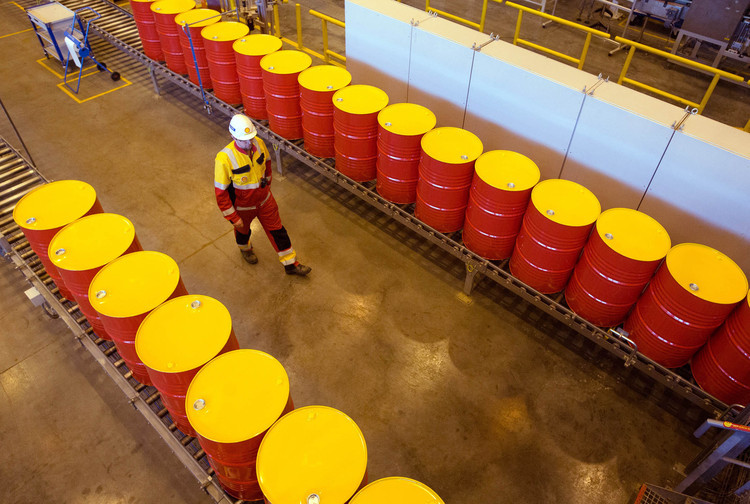
The real world of oil trading — where actual cargoes are bought and sold — is doing little to help the hedge funds and other speculators who placed record bets that OPEC and its allies would drive up prices.
Saudi Arabia, Russia and other big producers are trying to clear a global crude glut, but three months into the effort the physical oil market is still signaling plentiful supplies. The persisting excess offers little comfort to financial traders, whose bets that futures prices will rise equate to about $50 billion in nominal terms.
The signs of physical oversupply abound from Europe to West Africa to the U.S. A North Sea grade that helps to set the global Brent benchmark is trading near its weakest in almost two years. In West Africa, lackluster demand means Angolan crude cargoes are selling more slowly than in previous months. In America, a closely watched price relationship between the crude in a production region in Texas and a storage hub is flashing oversupply too.
“The physical market is not really on fire,” said Olivier Jakob, managing director of consultancy Petromatrix GmbH. “The OPEC cuts were good enough to prevent a repeat of the glut of last year, but it’s a different story if you want to have oil at $60 or $70.”
Brent crude futures traded at $51.67 a barrel at 3:41 p.m. on the ICE Futures Europe exchange in London. Earlier they traded as high as $52.18.
While few expected the Organization of Petroleum Exporting Countries and 11 other producers to eliminate a surplus overnight, the oil glut punishes bulls by dragging down futures markets that are ultimately anchored to physical price benchmarks. Even though banks including Morgan Stanley, Bank of America Corp. and Citigroup Inc. expect higher prices later this year, investors have been closing their bets on a rally since late February.
The value of long positions for Brent and West Texas Intermediate crude, the global and U.S. benchmarks, reached a combined $56 billion on Feb. 23, the highest since the Organization of Petroleum Exporting Countries announced the output cuts in late November. Those bets, measuring futures and options positions, indicated that investors expected prices to rise. In recent days, the value of those contracts has dipped to $49.3 billion. In barrel terms, speculative trades reached a record on Feb. 24.
Angola, Kazakhstan
The sell-off in financial markets comes as the physical market shows continued signs of oversupply. Cargoes from Angola for loading in April are selling more slowly than in previous months, according to four traders. Vitol Group BV recently released barrels of Nigerian oil it had been storing in South Africa, adding immediate supplies to the market. Total SA followed suit this week.
North Sea Ekofisk crude last week dropped to a 22-month-low against Dated Brent, a global benchmark that ultimately helps define the price of oil on the ICE Futures Europe exchange in London. Meanwhile, Kazakhstan’s Kashagan field in February boosted production to an estimated 170,000 barrels a day, just five months after start up, the Paris-based International Energy Agency said in a monthly report Wednesday. Caspian crude earlier this month traded at an 85-cent discount to its benchmark, compared with 5-cents a year earlier.
It’s not just in seaborne markets where gluts are enduring. West Texas Intermediate crude at Midland, Texas — a pricing point for booming supplies from the Permian shale basin — is the cheapest since September relative to the same crude in another key pricing point, the storage hub of Cushing, Oklahoma.
The WTI price difference between Midland and Cushing, which has swung from plus $1.40 a barrel in December to minus $0.85 a barrel now, is due to maintenance at a refinery that consumes the crude, rising Permian output and lower export demand due to competition from West African crude.
“You need prices to come off to open export arbitrage,” said Dominic Haywood, an analyst at Energy Aspects Ltd. in London. “Especially if West Africa is weak and competing with U.S. barrels into Asia.”
Atlantic Supplies
The destinations for crude cargoes provide evidence of the oversupply, according to JBC Energy GmbH, an oil consultant based in Vienna.
“Supply is still plentiful across the Atlantic basin as can be seen in the high arbitrage volumes targeting Asia,” due in part to a boost in production in the Mediterranean region and Brazil, JBC analyst Eugene Lindell said. “Global stocks have not been coming down as fast as people hoped they would.”
Even so, many financial speculators and analysts remain upbeat that OPEC and its allies will rebalance the market. Global stockpiles will decline by about 500,000 barrels a day in the first half of this year if OPEC sticks to its pledged cuts and all other market factors remain constant, according to the IEA.
“The OPEC cuts are real and are cleaning up the market,” Citigroup analysts including Seth Kleinman wrote in a report earlier this week.
Recommended for you
